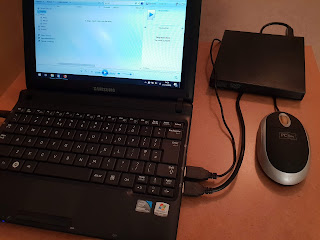I have been downloading and ripping MP3's since about 1998; so I've accumulated quite a few. Looking through my library recently I decided it was time for a clear out and an upgrade. Any file that was below 256 Kbps was deemed unsuitable and a replacement sought. The majority of the time this simply meant re-ripping CDs at 320 Kbps, but I soon found some CDs wouldn't rip. No matter how many times I cleaned the disc, cleaned the laser and screamed at the screen, some CDs just weren't playing ball. In a vain attempt to overcome the situation I even bought another copy
of one particularly frustrating disc, a-ha's "Minor Earth Major Sky", but the new copy was even worse than the original.
Nope, it wasn't copy protection, it wasn't
scratches, it wasn't bronzing. At first I found this quite mysterious as I had ripped all of these CDs previously. But it soon occurred to me that this was some years ago using different PCs and different operating systems. The majority of my MP3s were created on a desktop machine with an internal optical drive running Windows XP. Windows 10 on a modern laptop just couldn't get the job done.
My old 'copy protection workaround' of using an optical output from a traditional CD player was so laborious that it was impractical for the number of CDs I was looking at. Google searches weren't really turning up any useful information and I became increasingly frustrated. I gave up.
Fast forward about 3 years and I found a solitary forum post that seemed to describe the exact issue I was having. The poster had identified the one thing all of these discs had in common. Three dirty letters: WEA. It seems discs manufactured by WEA are different, and not in a good way. Most solutions for difficult to rip CDs centre around using old optical drives. It seems more recent hardware just can't cope with some discs, and for my laptop, as with many others, this meant WEA discs.
Today, most people seem to have abandoned optical drives and CDs (one colleague recently said: "Who buys CDs in this day and age?"). Not being 'most people' means there are bargains for the rest of us. I was able to find an old Sony USB optical drive on eBay for just a few pounds.
As soon as the new drive arrived I plugged it in, threw in a copy of Madonna's "Music" and watched it spit the disc out like it was poison. Next I tried David Gray's "White Ladder" and Windows Media Player crashed as soon as the drive span up. When I tried my nemesis "Minor Earth Major Sky" the drive disappeared from explorer and Windows crashed without so much as spinning up the disc.
In order to eliminate the laptop as the source of the issue I plugged the drive into my work laptop. As the disc began to spin I noticed the laptop was not only reading the disc, it was actually playing the audio! With lightning speed I hit "Rip CD" and crossed everything. Immediately Windows put up the shutters. My work machine is obviously configured not to allow ripping. Foiled again.

Recently I was working on my laptop whilst simultaneously trying to keep one of my children entertained. In desperation I picked up an old netbook I had lying around the office and gave it to her. It took a minute or to for the light bulb moment to happen but when it did, it triggered intense negotiations to retrieve the netbook and convince a two year old that Peppa Pig wasn't as important as ripping CDs.
In hope rather than expectation I plugged in the optical drive and fired up Media Player. With trembling hands I placed HARD-Fi's "Starts of CCTV" into the drawer and pushed it closed. Yes,it read the disc and started to play it; but I'd been this close before. However, when I clicked "Rip CD" this time... it did. Not only did it rip this CD but it also devoured David Gray, breezed through Madonna, didn't even pause on ripping New Order and Prince was a push over. This just left 'the big one', the most difficult to rip of them all: "Minor Earth Major Sky". At first the CD span but didn't play and then the first track ripped but it then returned an error and the drive dropped off the list of available devices. Damn you Morten Harkett.
Yes, repeating the same thing over and over again expecting a different result is insanity; but I decided to restart, plug the drive back in and try again. I was not going to be beaten by an eighteen year old CD. And I'm pleased to say that I wasn't beaten, second time around the CD ripped without so much as a murmur of protest.
So, I have finally ripped all of the discs that were giving me trouble and am now about half way through ripping my CD collection. So if you will excuse me I'm about to pull box number 12 off the shelf and get stuck in.
Oh, and if you know of anyone who would like to buy a copy of aha's "Minor Earth Major Sky" do let me know.
 Back in 2011 I lamented on an inexorable decline in the quality of Jean-Michel Jarre's music. The album "Electronica I" was a step in the right direction, but didn't really do much to dissuade me of this belief. The second instalment of "Electronica" continued this slight upturn with my dream collaboration of Jarre and Pet Shop Boys finally becoming a reality in the brilliant track "Brick England".
Back in 2011 I lamented on an inexorable decline in the quality of Jean-Michel Jarre's music. The album "Electronica I" was a step in the right direction, but didn't really do much to dissuade me of this belief. The second instalment of "Electronica" continued this slight upturn with my dream collaboration of Jarre and Pet Shop Boys finally becoming a reality in the brilliant track "Brick England".












